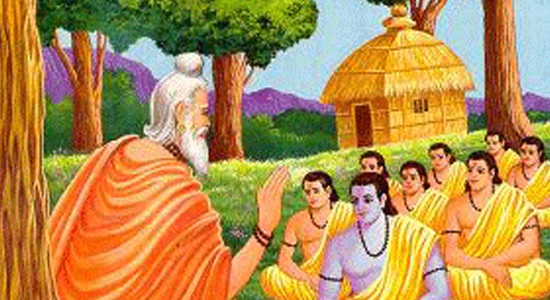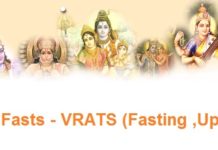1.1. Introduction
- The tradition of entire Indian sub-continent, Bharat, Our entire tradition was based and rooted into the Gurukul tradition. Right from the time Rama or Krishna went to Gurukul the pattern had been the same for more than 10,000 years.
- The entire system was systematically and cunningly destroyed by the then British Government for their vested interests.
- Let us now reflect on the past to understand, what significance it holds for us now.
Why was it destroyed? What good can we imbibe from it? Why is it relevant today? How did the destruction of Gurukul fulfil the British agenda and how did it destroy Bharat holistically? Let us see.
#HinduHolocaust
1.2. State of Indian Education, before Macaulay’s English Education act, 1835
1) Major Data Sources
- Official Survey of Indigenous Education in the Madras: 1822-26, which was order by the British Government and executed by the district collectors in accordance to the circular sent from the Board of Revenue.
- Extracts from W. Adam’s State of Education in Bengal: 1835-38
- Unofficial survey made by G.W. Leitner in Punjab: 1882

2) Overview
- The Hindu or Indian Education system, which was at least a few thousand years old, older than most Abrahamic religions, was completely wiped out in a century during the British Rule.
- Based on the reports, the Governor, Sir Thomas Munro, was of the view that institutional education of the boys between the ages of 5 to 10 years appeared to be a little more than 1/4 th , nearer to 1/3 rd of the boys of that age in the Presidency as a whole [Reference#i]. Madras Presidency represented literally 1/3 rd of India.
- The survey carried out in Madras Presidency was done a specific prescribed format. The numbers of schools, colleges were to be mentioned. The student population had to be described as per gender (Male, Female, Transgender) and as Brahmin, Vaishya, Shudra and Other castes.
- Sir Thomas Munro, the Governor, observed that the Indian education would certainly have been far ahead during its glorious peak [Reference#ii], during the times the times of Takshila and Nalanda University. Indian education system was already damaged and suffering due to series of invasion and increasing poverty of the population.
- As per W. Adam’s report, there was at least one school in every village. He observed that there exist about 1,00,000 village schools in Bengal and Bihar around the 1830s [Reference#iii].
3) Comparison to state of education in Europe and particularly England
- The content of studies was better than what was then studied in England.
- The economy at which education was imparted impressed British collectors that they suggested it be replicated in Britain [Reference#iv], which indeed did inspire the British education later on.
- The duration of study was more prolonged. The collectors (apart from Nellore and Salem) stated that the duration of study varied from a minimum of 5 to about a maximum of 15 years [Reference#v]. Average schooling year in Britain was 1 year in 1835, and 2 years in 1852.
For Indian traditional schools typical age of enrollment was 5 years. The duration of schooling hours was also much longer. It started at 6 AM, had one or two short intervals for meals, finishing about at sunset[Reference#vi]. - The method of school teaching was superior and it is this very method which is said to have greatly helped the introduction of popular education in England but which had prevailed in India for centuries.
- School attendance, especially in the districts of the Madras Presidency, even in the decayed state of the period 1822-25, was proportionately far higher than the numbers in all variety of schools in England in 1800[Reference#vii].
- The conditions under which teaching took place in the Indian schools were less dingy and more natural; and, it was observed, the teachers in the Indian schools were generally more dedicated and sober than in the English versions. Education was imparted without violence [Reference#viii].
4) A few unique aspects of the primary education (As identified by British)
- Monitorial System [Reference#ix ][Reference#x] – For initial mode of learning and not for higher education a novel method of education existed where the pupils were monitors of each other.
Example – The tutor would choose some 3-4 monitors and impart them a particular lesson. For instance – the multiplication table. The monitors would sit crossed legged on a sandy ground, and recite the multiplication table (sometimes like a song), “one by itself makes one.” Along with reciting, the monitor would also write the same on the sand with his finger. After this other students repeated the same task. The ground by now had to be planned for the next lesson. The monitors would then start with the multiplication table of two and so on. The process was unique as it involved the following - Low cost to benefit ratio. No use paper and pen.
- Redundancy: There were 3-4 monitors and thus if even if one of them made a mistake, he was likely to be corrected by the other three. All four were unlikely to make the exact same mistake.
- Scalability: The system allowed a single teacher to handle a large number of students.
- The stolen idea: The system was adopted by the British, repackaged as Bell’s “Madras System” with the idea to produce a “Christian Education” and “train children in the practice of such moral habits as are conducive to the welfare of society.” The system was introduced in several countries. With time however it was replaced with other systems particularly – the lecture model of direct instruction delivered to passive students grouped into classes by age.
- Teaching not confined to classroom and linked to nature.
- Close relationship between student and teacher.
- Memorization: The children were known to memorize multiplication tables as far as 100 [Reference#xi]. In current era, it is often limited to 16.

Balasant (child saints) in a traditional Gurukul of the current era. This particular Gurukul has been attacked several times by anti-Hindu forces. One such being in 2013 and 2014 by (1) Father Edward of Bangalore (2) Samaya TV (3) State Government CWC.
5) Imparted Education to commons
- The term Scheduled caste and Scheduled Tribes did not exists during that era, but these were mentioned as ‘other castes’ (also known as ‘pachamas’) in the report [Reference#xii].
- 70% of the students (70% in Salem and Tinnevelly to over 84% in South Arcot) were from ‘Shudra’ jati [Reference#i] and ‘other castes’. This was the trend for most of country. The lowest was observed in Telgu speaking districts 35%.
- Around 20% of the students were of of ‘Brahmin’ and the ‘Vaishya’ jati [Reference#i].
- In some villages of Bihar, ‘Chandal’ and ‘Dom’ jati accounted for 50% of the students. In Bihar, nowhere did the ‘Brahmin’ and ‘Kayastha’ jati accounted for more than 40% of the total students [Reference#xiii].

All professions, traditions were respected. There was dignity of labor, farmer, priest, every part of the society. For example, a book on agriculture, used in that era, the second verse of the book, declares, “That if a learned priest who has knowledge of four Vedas, even after learning four Vedas if looks down at farming considering it inferior, that person is surely to suffer from poverty”. The context of this verse is that all professions, including farming should be respected. In such a education system, it was impossible to have caste bias and division and weakening of Hindus on the basis of caste as we see today.
प्रजापतिं नमस्कृत्य कृषिकर्मविवेचन्।
कृषकाणां हितार्थाय ब्रूते ऋषिपराशरः॥१॥
पराशर ऋषि ब्रह्मा को प्रणाम करके किसानों की भलाई के लिए कृषि कर्म का विवेचन करते हैं||१||
चतुर्वेदान्तागो विप्रः शास्त्रवादी विचक्षणः|
अलाक्ष्म्या गृह्यतो सोऽपि प्रार्थनालाघवान्वितः॥२॥
चारों वेदों में पारङ्गत, शास्त्रों का ज्ञाता, मेधावी ब्राह्मण भी यदि कृषि कर्म को हीन समझता है तो वह् दरिद्रता से ग्रस्त हो जाता है॥२॥
Rishi Parashara, in his treaties on agriculture, begins with salutation to Brahma, invoking his presence, such that whatever he reveals is for the best of the farmers. Then he goes on to say that if a learned priest who has knowledge of four Vedas, even after learning four Vedas if looks down at farming considering it inferior, that person is surely to suffer from poverty.
6) Home tutoring, and apprenticeship (Agraharams)
- This was not covered by the survey other than by a few Collectors.
- Girls were mostly home tutored.
- Home schooling was usually conducted in Agraharams.

Traditional Agraharams (home schools)
7) ‘Institutions of Higher learning’
- The term, ‘Institutions of Higher learning’ was used in the report to indicate colleges.
- The exact data on total number of colleges is not reliably available, as many collectors had not reported the required data, but based on the districts that were rigorously surveyed, for every 10 schools, there was one ‘Institute of Higher learning’.[[i]]
Rajahmundry – 279 colleges – for about 1000 villages, Coimbatore – 173 colleges, Guntoor – 171 colleges, Tanjore – 109 colleges, Nellore – 107 colleges, North Arcot – 69 colleges, Salem – 53 colleges, Chingleput – 51 colleges, Masulipatam – 49 colleges. - The disciplines of Theology, Metaphysics, Ethics, and to a large extent of the study of Law was dominated by ‘Brahman’ jati[xiv].
- But the disciplines of Astronomy, Medical Science and technology based disciplines (such as Iron Work, Metallurgy, Ship building, Mechanics, Textile machinery) were dominated by other jatis, notably ‘Shudra’ jati[xiv].
- It should also be noted that adherence of a jati to discipline was not rigid. A person of ‘Shudra’ jati, could very well be in a discipline dominated by the ‘Brahman’ jati and vice-versa.

In modern era we are told that Hindus were uneducated until they were invaded. However the same invaders, in their survey give the following numbers for number of colleges (we are not talking about schools here). The exact data on total number of colleges is not reliably available, as many collectors had not reported the required data, but based on the districts that were rigorously surveyed, for every 10 schools, there was one ‘Institute of Higher learning’.[[i]] Rajahmundry – 279 colleges – for about 1000 villages, Coimbatore – 173 colleges, Guntoor – 171 colleges, Tanjore – 109 colleges, Nellore – 107 colleges, North Arcot – 69 colleges, Salem – 53 colleges, Chingleput – 51 colleges, Masulipatam – 49 college.
8) ‘Institutions of Higher learning’ – Medical Science and Surgery
- The data on exact number of colleges that were offering MS degree is not reliably available (One reference puts it at 1500 for Madras Presidency alone [ii]).
- The educators and practitioners of surgery were often of the Shudra jati. Amongst them the Nayi jati was considered to the best by the British. In modern era however Nayis are considered to be marginal barbers [iii][iv].
- The education Ayurveda (Indian traditional medicine) was based on ancient texts such as Charaka Saṃhitā.
Sutra Sthana (General principles), Nidana Sthana (Pathology), Vimana Sthana (training of a physician, ethics, etc), Sarira Sthana (embryology& anatomy of a human body (with a section on other living beings)), Indriya Sthana (Sensory organ based prognosis), Cikitsa Sthana (Therapeutics), Kalpa Sthana (Pharmaceutics and toxicology), Siddhi Sthana (Success in treatment) - Other text books : Sham Raj, Nighant, Sharang Dhar, Bhashya Parichehed, Madhava Nidan, Vagbhat
- The education of surgery was based on ancient texts such as medico–surgical compendium Suśruta Saṃhitā (c. 500 BC), which were written by the ayurvedic physician Sushruta (c. 800 BC) who is considered the father of modern Surgery. It covers anatomy, treating fractures, general surgery, reconstructive plastic surgery, anaesthetics, rhinoplasty, perineal lithotomy, the suturing of wounds, and the extraction of foreign objects etc. The level of detail it covers goes into describing how foetus develops seven layers of skin, naming each layer and the specific diseases which may affect that layer in adult life, which is unimaginable for that era and made possible today only by microscopy, ultrasonography and X–rays.
- ‘Cutting of nose’ or “naak kata leyna” has traditionally been considered as a sign of shame in India. There have been numerous cases when a British officer, a high ranking officer, or his sub-ordinate, lost his nose partially or completely during war (with an Indian kingdom), as a sign of shame inflicted on him. Battles between Haider Ali and Colonel Coote being noteworthy examples [[v]]. Sometimes the cut nose was completely burned to avoid being surgically fixed. Even such cases were treated by a complete reconstruction of nose along with nostrils. But it was only possible by an Indian surgeon (or Nayi). Interestingly such surgeons were available at the village level. In current era it is unimaginable to find a surgeon let alone a plastic surgeon in an Indian village. The Indian surgical practises were not only advanced they involved use of anaesthesia [vi] which was unknown to the west as thus the operation was not barbarous and painful as in the west. Watch this video to see the original technique – https://www.youtube.com/watch?v=cV-xZFIc6m4
- The education and practise of surgery was not limited to male population. For example – W Adam, in his report, pp 119 – 122, for district Purneah, described an old woman surgeon who had become reputed for extracting the stone from the bladder.
- The practical value of this traditional system of education of medical science and surgery was presence of low price and yet reliable medical facilities even at the village level. W Adam for example in his report describes the Thana of Nattore in the district of Rajshahy – The populationwas 1,20,928; it had 485 villages had 123 native general medical practitioners, 205 village doctors, 21 smallpox inoculators, 297 women-midwives[[vii]]. In modern India, in 1973, the Kartar Singh Committee of the Government of India had recommended that there should be 1 midwife (Auxiliary nurse midwife – ANM) available per 10,000-12,000 people [[viii]].For Thana of Nattore as surveyed by W Adam, the ratio was amazingly 1 midwife per 408. This is 2456% more than what the government is recommending in the modern era. This shows that the availability of health care specialists was amazing. In modern era the child mortality rate in India is extraordinarily high, at 48 per 1000, for year 2015[[ix]].
- Smallpox inoculation (vaccination) is said to be the first vaccination developed, and Edward Jenner (in 1796) is credited to be the founding father. But much like how plastic surgery was copied from India, same is the case with smallpox inoculation, which was practiced in India since ancient times [[x]][[xi]][[xii]][[xiii]][[xiv]][[xv]]. However unlike surgery the credit has not been given to the Indian origin.
‘Cutting of nose’ or “naak kata leyna” has traditionally been considered as a sign of shame in India. There have been numerous cases when a British officer, a high ranking officer, or his sub-ordinate, lost his nose partially or completely during war (with an Indian kingdom), as a sign of shame inflicted on him. Battles between Haider Ali and Colonel Coote being noteworthy examples [[v]]. Sometimes the cut nose was completely burned to avoid being surgically fixed. Even such cases were treated by a complete reconstruction of nose along with nostrils. But it was only possible by an Indian surgeon (or Nayi). Interestingly such surgeons were available at the village level. In current era it is unimaginable to find a surgeon let alone a plastic surgeon in an Indian village. The Indian surgical practises were not only advanced they involved use of anaesthesia [vi] which was unknown to the west as thus the operation was not barbarous and painful as in the west.
9) ‘Institutions of Higher learning’ – Architecture
- The data on exact number of colleges is not reliably available (One reference puts it at 2200-2300 for Madras Presidency alone. [xv])
- The architectural principles of Hindu temples in India are described in Shilpa Shastras and Vastu Sastras and civil Construction described in Sthapatya Shastra. There are an extremely large number of voluminous books entirely or partially dedicated to this subject, Agamas being one of them. Architecture. Temples throughout the world (India, Cambodia, and Indonesia) were constructed as per these.
- The ancient texts of Parāśara states that all crafts were practiced by anyone irrespective of family’s occupation [[xvi]].
- Paraiyar jati were one of the pioneers educators (acharyas) and experts in the field of temple architecture. Some Examples of their Architectural marvel –
- Padmanabhaswamy Temple : Known for 28 pillar balustrades, which can produce musical notes in all four corners when tapped.
- Meenakshi Amman Temple, Madurai : One of the most magnificent temples
- Brihadeshwara Temple, Thanjavur : The world’s largest granite structure. The chief architect and engineer Kunjara Mallan Raja Raja Perumthachan’s mother belong to the Paraiyar jati.
- In 1890, A.O. Hume, Collector of Madras, issued a notification, making it a legal offence for Paraiyar jati to make temples. Paraiyar today are projected as a caste that was highly oppressed and abused by Brahmins and all this involves a great lot of caste politics and social issues. However some historians believe that it was systematic intervention by the British that resulted in backwardness of the community which were traditionally great architects [xv].
10 ) Kerala school of astronomy and mathematics [xvii]
- The achievements of Kerala School of mathematics were documented by Englishman C. M. Whish in 1835. This is about nine years later to the date of the Survey of Indigenous Education in the Madras 1822-26.
- In attempting to solve astronomical problems, the Kerala school independently created a number of important mathematics concepts.
- Some noteworthy discoveries and contributions were made in the field of :
Infinite series, Calculus, differentiation and integration, Functions, Trigonometric functions, derivatives of trigonometric functions (later know as Taylor-Maclaurin) infinite series of sin(x), cos(x) and arctan(x), Leibniz method using quadrature, infinite series of arctan(x), infinite series expression for π (later known as Gregory series), rational approximation of the error for the finite sum of their series, special infinite series to obtain a more rapidly converging series for π.
Destruction of Gurukul, Mutts and Hindu Universities
Macaulay’s English Education act, 1835To Zachary Macaulay, 12 October 1836
Our English schools are flourishing wonderfully. We find it difficult, indeed at some places impossible, to provide instruction for all who want it. At the single town of Hoogley fourteen hundred boys are learning English. The effect of this education on the Hindoos is prodigious. No Hindoo who has received an English education ever continues to be sincerely attached to his religion. Some continue to profess it as a matter of policy. But many profess themselves pure Deists, and some embrace Christianity……. It is my firm belief that, if our plans of education are followed up, there will not be a single idolater among the respectable classes in Bengal thirty years hence. And this will be effected without any efforts to proselytise, without the smallest interference with religious liberty, merely by the natural operation of knowledge and reflection. I heartily rejoice in this prospect…

No doubt, education decayed and illiteracy increased during the British period.

According to Sir Henry Lawrence, there was one school for every 1783 inhabitants of the most backward division of the Punjab at the time of annexation. But thirty years later in 1881, ‘there is one school of whatever sort, to every 9,028 inhabitants’, according the President of the Educational Commission.
William Adam estimated that there was 11% literacy in the Thana of Nattore during 1830s. A century later the British considered this an accomplishment in many parts of India.
References
[i]The Beautiful Tree, Dr. Dharampal, Page 35
[ii]Dr. Dharampal’s disciple, Rajiv Dixit’s lecture on Indian Education System (widely available on youtube).
[iii]https://en.wikipedia.org/wiki/Nai_(caste)#cite_note-29 People of India Gujarat Volume XXI Part Three edited by R.B Lal, P.B.S.V Padmanabham, G Krishnan & M Azeez Mohideen pages 1415-1418
[iv]The Beautiful Tree, Dr. Dharampal, Page 35
These surveys began to be made from 1812 onwards, and their main purpose was to find out what number of such medical men were in receipt of assignments of revenue. Some details of the castes of these practitioners may be found in Madras Board of Revenue Proceedings of 17 September 1821, and of 9 March 1837, and other proceedings referred to therein.
[v] J. C. Carpue, ‘An Account of Two Successful Operations for Restoring a Lost Nose from the Integuments of the forehead…to which are prefixed Historical and Physiological Remarks on the Nasal Operation including Descriptions of the Indian and Italian Methods,’ London, 1816, pp.36-38 AND
SOME NARRATIONS ON INDIAN AGRICULTURE, PLASTIC SURGERY, TANK IRRIGATION SYSTEM, CHRONOLOGY AND ARCHITECTURE, INDIAN COTTON TEXTILE INDUSTRY AND OIL WELLS IN BURMA –Dharampal Collected Writings Volume II, pp.7-9 http://samanvaya.com/dharampal/frames/downloads/vol2.PDF
[vi] Sushruta (1907). “Introduction”. In Kaviraj Kunja Lal Bhishagratna. Sushruta Samhita, Volume1: Sutrasthanam. Calcutta: Kaviraj Kunja Lal Bhishagratna. pp. iv.
[vii] The Beautiful Tree, Dr. Dharampal, Page 52
[viii]https://en.wikipedia.org/wiki/Auxiliary_nurse_midwife
[ix]http://data.worldbank.org/indicator/SH.DYN.MORT
[x]India Science and Technology in the eighteeth century – Dr. Dharampal, Page 2, Also see mid-eighteenth century Tracts on Inoculation in the British Museum
[xi]Fenner F, Henderson DA, Arita I, Jezek Z, Ladnyi ID. Geneva: World Health Organization; 1988. Smallpox and its eradication; pp. 369–71
[xii]Dowdle WR. The principles of disease elimination and eradication. Bull World Health Organ. 1998;76(Suppl 2):22–5.
[xiii]Fitchett JR, Heymann DL. Smallpox vaccination and opposition by anti-vaccination societies in 19 th century Britain. Hist Med. 1995;2:E17.
[xiv]Riedel S. Edward Jenner and the history of small pox and vaccination. BUMC Proc. 2005;18:21–5
[xv]The College of Physicians of Philadelphia. The history of vaccines. Available from: http://www.historyofvaccines.org.
[xvi] Stella Kramrisch (1958), Traditions of the Indian Craftsman, The Journal of American Folklore, Vol. 71, No. 281, Traditional India: Structure and Change (Jul. – Sep., 1958), pp. 224-230
[xvii]https://en.wikipedia.org/wiki/Kerala_school_of_astronomy_and_mathematics





[…] Photo Courtesy: https://hindu.bz/systematic-destruction-of-gurukul/ […]